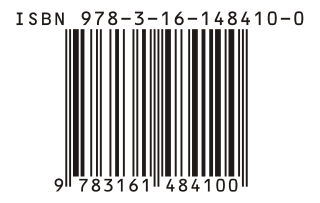
The Fantail is a popular breed of fancy pigeon. It is characterised by a fan-shaped tail composed of 30 to 40 feathers, abnormally more than most members of the pigeon family, which usually have 12 to 14 feathers. The breed is thought to have originated in Pakistan, India, China or Spain. There are several subvarieties, such as the English Fantail, the Indian Fantail, and the Thai Fantail. Charles Darwin used it as one of the examples in the first chapter of On The Origin Of Species.

The domestic pigeon is a pigeon subspecies that was derived from the rock dove. The rock pigeon is the world's oldest domesticated bird. Mesopotamian cuneiform tablets mention the domestication of pigeons more than 5,000 years ago, as do Egyptian hieroglyphics. Research suggests that domestication of pigeons occurred as early as 10,000 years ago.

The English Short-faced Tumbler is a breed of fancy pigeon developed over many years of selective breeding. English Short-faced Tumblers along with other varieties of domesticated pigeons are all descendants from the rock pigeon. The English Short-faced Tumbler is one of the oldest breeds referred to in Moore's book of 1735.

The Birmingham Roller is a very popular breed of domesticated pigeon that originated in Birmingham, England, where they were developed via selective breeding, for their ability to do rapid backward somersaults while flying. As the name suggests and as also mentioned by Wendell Levi in his book The Pigeon, this breed was developed in and around the City of Birmingham in England. The Birmingham Roller has a flying type and a show type. Show Rollers are larger than the flying variety, and are bred just for show. A similar breed called a Parlor Roller look much like Birmingham Rollers, but can't fly; rather, they spin backwards, somersaulting on the ground for many yards. Oriental Rollers are another aerial performer and come in many colour varieties. Some fanciers fly their rollers in competition, both locally and nationally. There is even a World Cup competition that includes several other countries. Kits are scored for quality and depth, as well as the number of birds that roll at the same time, referred to as a turn or break. The Birmingham Roller is a very popular breed of performing pigeon, with around 10,000 breeders worldwide.
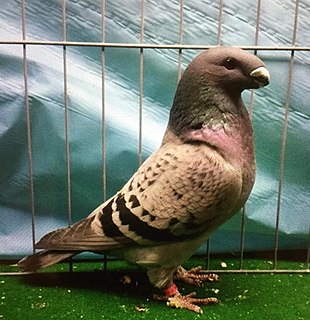
The American Show Racer pigeon is a breed of domestic pigeon that began in the early 1950s with the finest Racing Homers, selectively bred for their breed type. Pigeon historian Wendell Levi mentions Show Pen Racers in his book The Pigeon. He describes the early development of the breed in the United States and early breeders of the variety. In 1952, The American Show Pen Racer Club was formed at the National Show held in Des Moines, Iowa.

A Racing Homer is a breed of domestic pigeon that has been selectively bred for more speed and enhanced homing instinct for the sport of pigeon racing. A popular domestic pigeon breed, the Racing Homer is also one of the newest.

Tumbler pigeons are varieties of domesticated pigeons descendant from the rock dove that have been selected for their ability to tumble or roll over backwards in flight.

The Jacobin is a breed of fancy pigeon developed over many years of selective breeding that originated in Asia. Jacobins, along with other varieties of domesticated pigeons, are all descendants of the rock pigeon. It is in the Asian feather and voice pigeon show group. The breed is known for its feathered hood over its head.

Flying/Sporting is the name of one of three main groupings of breeds of domesticated pigeons used by pigeon fanciers in the United States. The other two are Fancy and Utility.

The Strasser is a breed of fancy pigeon developed over many years of selective breeding. Strassers, along with other varieties of domesticated pigeons, are all descendants from the rock pigeon . Apart from exhibition at pigeon shows, the breed is also used for utility purposes for producing squabs as food.
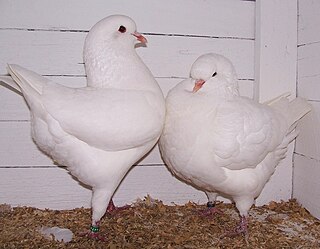
The King is a breed of pigeon developed over many years of selective breeding primarily as a utility breed. Kings along with other varieties of domesticated pigeons are all descendants from the rock pigeon . The breed is known for large size and suitability for squab production.
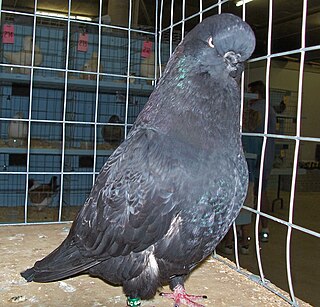
The English Long-faced Tumbler is a breed of fancy pigeon developed over many years of selective breeding. English Long Face Tumblers, along with other varieties of domesticated pigeons, are all descendants from the rock pigeon.
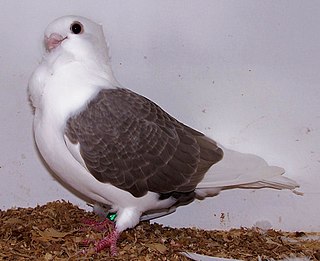
The Turbit is a breed of fancy pigeon developed over many years of selective breeding. Turbits, along with other varieties of domesticated pigeons, are all descendants from the rock pigeon . The breed is known for its peaked crest, short beak and frill of feathers on its breast.
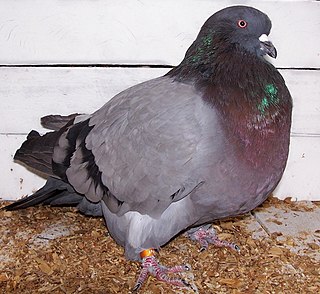
The Giant Runt is a breed of pigeon developed by selective breeding primarily as a utility and exhibition breed. American Giant Runts, along with other varieties of the domestic pigeon, are all descendants from the rock pigeon . The breed is known for its large size and suitability for squab production.

The Brunner Pouter is a breed of fancy pigeon developed over many years of selective breeding. Brunner Pouters along with other varieties of domesticated pigeons are all descendants from the rock pigeon . The breed is one of the most popular blower breeds.

The Dragoon is a breed of fancy pigeon developed over many years of selective breeding. Dragoons, along with other varieties of domesticated pigeons, are all descendants from the rock pigeon. The Dragoon was one of the breeds used in the development of the Racing Homer. A very old breed of British origin, referred to by Moore (1735).
The Altenburger Trumpeter is a breed of fancy pigeon developed over many years of selective breeding. Altenburger Trumpeters along with other breeds of domesticated pigeons are all descendants from the rock pigeon. There are several breeds of trumpeter pigeons which are known for their vocal cooing which sounds similar to laughter or trumpeting. The breeds with this ability are collectively known as "voice" pigeons.

The Barb is a breed of fancy pigeon developed over many years of selective breeding. Barbs, along with other varieties of domesticated pigeons, are all descendants from the rock pigeon . This breed was referred to by Shakespeare. It was also referred to with an illustration in Charles Darwin's Variation of Animals and Plants under Domestication.



















